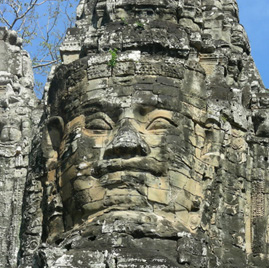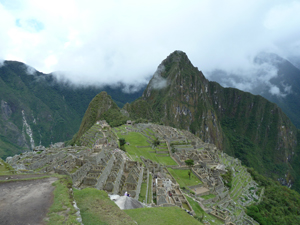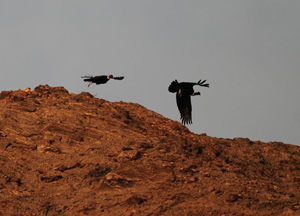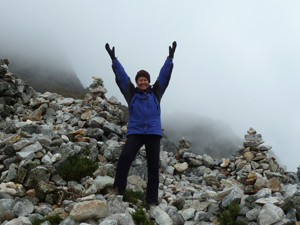|

 Karen's Perspective on Traveling Alone Karen's Perspective on Traveling Alone






















|
Trek to Machu Picchu
 My heart was beating furiously and I felt a little light headed after only 30 minutes of a 6 day trek to Machu Picchu, high in the Andes. My young 27 year old guide Carla told me to keep going very despacio but everything felt heavy--my lungs, my daypack, my legs. I had arrived in Peru four days before and done all the right things. I had drunk lots of coca tea, slept long hours and taken one 4 hour hike, all down hill so as not to overdue the adjustment to 12,000 feet altitude. But now my entire group of 11 others was at least 10 minutes ahead of me and I still had at least 1500 feet to climb before we arrived at our lodge for the night. I stopped and rested for 5 minutes, drinking as much water as I could and trying to get my bearings. I wondered if I had made a terrible mistake about my ability to do this trek to a place I had long dreamed of. Why hadnīt I just taken the van to the first lodge, lost 10 pounds before the trip or at least have been in better shape? The others seemed to be taking it better than me. They ranged in age from 17-60 years old and included 2 marathoners, 2 brothers in their 50īs who had summited Mt Whitney numerous times and done technical climbing and one fit National Park Service ranger, Shelley, who also happened to be my roommate. I had met her the night before and she had been sick for 2 days in Cuzco. I had barely had a slight headache before but now that the real trek had started, I was dying. I later found out that the majority of folks were taking Diamox, a drug to prevent altitude sickness.
My heart was beating furiously and I felt a little light headed after only 30 minutes of a 6 day trek to Machu Picchu, high in the Andes. My young 27 year old guide Carla told me to keep going very despacio but everything felt heavy--my lungs, my daypack, my legs. I had arrived in Peru four days before and done all the right things. I had drunk lots of coca tea, slept long hours and taken one 4 hour hike, all down hill so as not to overdue the adjustment to 12,000 feet altitude. But now my entire group of 11 others was at least 10 minutes ahead of me and I still had at least 1500 feet to climb before we arrived at our lodge for the night. I stopped and rested for 5 minutes, drinking as much water as I could and trying to get my bearings. I wondered if I had made a terrible mistake about my ability to do this trek to a place I had long dreamed of. Why hadnīt I just taken the van to the first lodge, lost 10 pounds before the trip or at least have been in better shape? The others seemed to be taking it better than me. They ranged in age from 17-60 years old and included 2 marathoners, 2 brothers in their 50īs who had summited Mt Whitney numerous times and done technical climbing and one fit National Park Service ranger, Shelley, who also happened to be my roommate. I had met her the night before and she had been sick for 2 days in Cuzco. I had barely had a slight headache before but now that the real trek had started, I was dying. I later found out that the majority of folks were taking Diamox, a drug to prevent altitude sickness.
I decided to just get on with it, stopping and breathing every 5-10 minutes. The setting was spectacular and I knew the lodge was settled on a pampa between various high glaciers. I made it to lunch and then the emergency horse arrived that I could place my pack on it and be free of the weight. Now the climb was mostly level or even a little downhill and I could see that I would be fine, if tired. I had decided long ago that I wasnīt willing to camp on the Inca Trail in the rainy season with the 20 somethings. I was staying at newly constructed and remarkably designed lodges along the Salkantay Trail, with www.mountainlodgesofperu.com . I had 2 friends in the Bay Area who had done the same trek, one camping out and one in the lodges. It cost a pretty penny but coming into the lodges after challenging treks with their comfy rooms, hot tubs and delicious and nutritious food was the right decision. Fifteen years ago I would have scoffed at the decadence I was now so enjoying.
When we saw the jaggy Salkantay peak and glacier covered in snow an hour later, it literally took my breath away. After a 2000 foot climb over 5 hours of hiking we arrived at the lodge and were greeted with hot tea and warm fires burning. Our head guide Javier, gave me the high five for making it, catching up with the others along the way. Javier was a trim 53 year old who had been leading treks for 30 years. He spoke perfect English with lots of American slang thrown in but mostly spoke to me in Spanish as he knew I wanted to practice. I shocked him when I asked if the hot tubs were clothing optional--he said he had never been asked before! Thatīs when I knew I really had become a Californian. All of the members of my group were Americans except for a youngish couple from Johannesburg, both of Indian descent and Muslim, who would become some of my favorites. Khursheed was a financial lawyer and her boyfriend of 8 months was Irshaad, a banker. It was Khursheedīs idea to trek and though they had all the right gear, neither one had really hiked before. Khursheed soon suffered from an upset stomach and an overworked knee. She would ride the horse for a couple of days, over the Salkantay pass and on the day when we did a 3000 foot downhill climb but she kept her spirits up.
The trek went from 15,000-9000 feet flowing through many ecosystems, including pampas, paranos, glaciers, elfin forests, cloud forests, and montane forests. At times, the landscape reminded me of the Eastern sierras or Rockies but then it changed dramatically when we entered the land of bamboo, bromeliads, a dozen different orchids, ferns, wild strawberries, citronella, passion fruit, coffee plantations and avocados. Perhaps the treks of the Himalayas and Swiss Alps are more famous than those of the Andes, but this trek is still considered one of the worldīs best. Of course, these are paths that have been used for hundreds or maybe thousands of years, especially during the days of the Incan civilization, perhaps mostly from 1300-1530 AD. Nine trails have been discovered that enter Machu Picchu and ours would enter from the south at the town of Aguas Calientes, with the famous Inca trail entering from the west at the Sun Gate. I enjoyed all the days of the 39 miles but my favorite was perhaps the longest, a 10 mile mostly downhill hike following a river course and making several creek crossings before coming to the confluence of 3 rivers, including the mighty Urubamba, which formed the Santa Teresa and the route of the train through the Sacred Valley to the heart of the Incan civilization and modern day heart as well, Cuzco. These are enormous rivers and with all the rainfall, luckily mostly at night, they were raging over their courses. The flow was something like those of the Kern, Yuba or Tuolumne in winter. The path itself was challenging, often strewn with rocks of all sizes, or at least somewhat muddy. My hiking poles were indispensable as well as my Ipod, especially for one section of 11 switchbacks as we climbed the Salkantay pass. To cross the pass, we all put on our warmest gear, including wool hats and gloves. A storm was threatening but we managed to reach the summit and make our way to a lunch spot where the cooks had luckily erected tents.
Ryan, a 27 year old MBA student at Cal and real estate developer became my buddy as well as his 60 year old social worker mom. Jackie was in great shape and made the trek with little problems. I admired her commitment to doing the trek while she still could and she found me entertaining. Coalescing a group like this is magical and Javier and Carla were talented at it. I supported their efforts by becoming the good time gal of extracurricular activities including bird watching, salsa dancing, poker and Scabble. But as much as I tried, I couldnīt get anyone except for Jackie, Carla and Khursheed to dance salsa with me. Javier said I was much too good a dancer for him to try and all the other men were likewise intimidated. Only a gay seeming laundry man at one of the lodges and the 2 cooks the last night (when I sang them a goodbye song in Spanish) were game. I did have my one salsa moment though. I had gone out dancing with Carla in Cuzco and asked the best dancer in the club to dance with me. He might have been all of 28 but he sweetly agreed and I had a blast, even while my lungs were bursting.
I was impressed by the logistics that it took to pull the trek off. Every morning, 5 wranglers would load all the food and our luggage on the pack horses and mules, then pass us along the way. After cooking a great breakfast, the cooks would walk ahead of us, arriving in time to prepare a delicious dinner and one day, a lunch in route. On the last day of the trek a local van met us to take us the last 15km to our lodge since the horses are forbidden along any of the Incan trails that go into Machu Picchu.
Most days of the hikes, I hung back with Carla, hiking slower than the others and stopping to look at birds. We identified maybe only 10 with the most dramatic being the caracara, 3 species of hummingbirds, and, as luck would have it, the Andean cock of the rock, a conspicuous almost entirely red bird that I had gotten up at the crack of dawn to see through a bird blind and at a distance in Ecuador. This time we had gotten up at 5:30am on the morning of our trek to Machu Picchu and as we were having breakfast, Shelly had spotted the sometimes reclusive bird on a very near branch outside the restaurant where it hung out for 10-15 minutes. I was mesmerized. I never saw the condor but this was a close second. Instead, one of the 2 older brothers in the group with their 2 teenage kids surprised me one day at lunch with an origami condor he had made for me.

We took the bus up to Machu Picchu and had an excellent 2 hour tour early in the morning before the crowds arrived from those taking the train. Location, location, location. If you wanted to reach Machu Picchu in the days on the Incans, it was an almost impossible climb and they could see their enemies from afar. The Incans were masters of construction, agriculture and astronomy. We visited on the day after the summer (for them) solstice and, as you may know, they knew exactly where the sun would hit the sun dial with a more exact calendar than the Mayan calendar, only needing to add a day every 11,500 years, quite a bit more exact than our leap year. The site high in the Andes in a cloud forest with the fog lifting and falling was truly magnificent. After the tour we had 3 hours to absorb the site on our own and after some exploring, I sat in one place high up near the Watch Tower and watched a hummingbird called a collared Incan for an hour. I had watched a special about hummingbirds on Nature and I could actually see the white of its tongue as it devoured the nectar from a bush with lovely red flowers. I watched the same hummingbird over and over, go after the nectar and then rest on a nearby perch. I was physically tired and it gave me time to reflect on everything I had seen, heard and felt over the last 6 days with no need to get anywhere. I took off my shoes and placed my umbrella over me to shield off the occasional rain, savoring the accomplishment that I had walked the path that many had walked before. The air was fresh, the view like that of the famous postcards with Waychu Picchu (young mountain) rising in front of the terraced remains. It felt mystical and familiar all at one. Had I been here before in a former life or just enough times in anticipation that I felt I was coming home? Maybe it was the absence of oxygen, but I definitely felt a spiritual high. After watching the hummingbird, I walked a little ways to watch an American kestrel, one of the smallest hawks, look for prey and then return over and over to its roost.
A few hours later, our group returned to Cuzco through the Sacred Valley by the famous train ride along the Urubamba River. I was drowsy but couldnīt keep my eyes closed for long as the scenery was spectacular and birds were numerous and colorful. The beauty and sacredness of this last week would hopefully be with me for the rest of my life.
Northern Coast and Condor Sightings
 I recovered from the trek by flying to Piura via Lima on route to explore the Northern coast. In some places the coast reminded me of Northern California with its rocky and rugged outcroppings. The difference is that it's pretty much surrounded by desert and it was the season to swim and sunbathe. My favorite location to play beach bum was in Punta Sal where I stayed for three days and celebrated my 52nd birthday with new friends from NYC and a woman from Oakland and her Peruvian boyfriend. I also had a very enjoyable day trip to explore the mangroves of Tumbes, along with 2 bird guides and a Peruvian ornithologist where we had some excellent sightings, including a Harris hawk.
I recovered from the trek by flying to Piura via Lima on route to explore the Northern coast. In some places the coast reminded me of Northern California with its rocky and rugged outcroppings. The difference is that it's pretty much surrounded by desert and it was the season to swim and sunbathe. My favorite location to play beach bum was in Punta Sal where I stayed for three days and celebrated my 52nd birthday with new friends from NYC and a woman from Oakland and her Peruvian boyfriend. I also had a very enjoyable day trip to explore the mangroves of Tumbes, along with 2 bird guides and a Peruvian ornithologist where we had some excellent sightings, including a Harris hawk.
My biggest unexpected adventure of the trip came when I was visiting an ecological reserve called Chaparri, outside of Chiclayo. I was very impressed with this dry forest reserve as it contains many spectacled bears as well as over 300 bird species. I met one of the leaders of the reserve, Rafael, who spotted me with my binoculars and the 5 lb book called Birds of Peru which I lugged around sometimes while birding. He asked me if I had seen condors and when I said I hadn't, he invited me to join him and some friends for an upcoming camping trip along the coast where they would be looking for many birds, especially condors and Humboldt penguins. This was the kind of invitation that I'm convinced pretty much only happens if you're traveling alone and am open to the unexpected. I jumped at the chance. Rafael and a few others had formed an advocacy group and recently gotten the Ministry of Interior to declare a large area called Illescas and named for the islands offshore, as a protected zone. Our expedition of 7 men and me left at 5:30am and we drove over an area that looked like the surface of the moon before reaching the Pacific Ocean and driving another 1 1/2 hours along the beach, causing huge flocks of pelicans to soar out of our way. We reached a campsite where a grove of cypresses protected us from the sun and wind. One of the group was a professional composer and guitarist so we spent hours singing boleros and classics like Gracias a La Vida, one of my favorite pastimes. Late in the first day we went exploring a nearby side canyon by truck and immediately saw two wild jackasses who broke into a run. I felt like I was part of the filming of Planet Earth as I got out my camera and videotaped the wild ride. Just as we were recovering from the chase someone yelled out "Condors!" and there they were, 7 in all, circling overhead with their 6 foot wingspan and finally landing briefly before taking off again. Rafael is the head of a condor project in Peru where their first task is to determine how many are still left in Peru. The estimates are between 500-1000 and to see 7 at one time was considered a very lucky experience. Next I heard a faint sound of some strange animals and scrambled up a hill to get a shot of wild goats along a craggy outcropping. The next day was also fruitful in spotting a handful of Humboldt penguins, a flock of lovely pink flamingos and most dramatically of all, a coral snake, the second most venomous snake in the world. When the snake was sighted, Rafael ran to grab a stick and it, placing his thumb firmly behind its head so it couldn't bite him. At first I thought he only wanted to take photos of it as he is perhaps Peru's leading wildlife photographer. But no, he actually was soon putting it inside a plastic bottle to take back to the snake exhibit area in Chaparri. I closely admired its beautiful orange and black patterns once it was safely in the bottle and marveled once again at all that I had witnessed in the last month of the wonders of Peru, both natural and human made.
Back to the Andes
After 2 weeks along the sunny and dry coast, every pore of my body was happy to explore the Northern Highlands where the Cordillera Blanca and Negra are and some colonial towns with names like Chachapoyas, Leyembamba and Cajamarca retain their Andean charm. I took the night bus from Chiclayo to Chachapoyas and slept almost the entire way except for 20 minutes around 3am when the air was turned off for no apparent reason. Leave it to the gringa to complain as it was hot and stuffy. Itīs such a cultural phenomenon here as no one likes to complain about almost anything and are ready to suffer rather than appear demanding.
I arrived in Chachapoyas and had arranged for a hike from the little village of Levanto back down to Chachapoyas. My local guide Juana and I went first to search for the spatuletail hummingbird, my first of 4 attempts to find it. Itīs an endemic little hummingbird with two ends on its long tail that it raises up to hit together. We walked along a Pre-hispanic trail, made dangerous at times because of the large uneven rocks and rain. But to be back in the Andes with the clear views of the surrounding terraced fields was invigorating.
 The next day I joined a group to hike to the Gotca waterfall, the 3rd highest waterfall in the world. It was a long and pretty challenging 10 mile, 6 hour hike as we stopped to look for the national bird of Peru, the fabulously all red cock of the rock which I had seen near Machu Pichhu but not since. Even though the group just ahead of us saw 4 of them deep in the woods we came up short. The waterfall was lovely though with clear views of it for most of the 3 hours it took to reach it.
The next day I joined a group to hike to the Gotca waterfall, the 3rd highest waterfall in the world. It was a long and pretty challenging 10 mile, 6 hour hike as we stopped to look for the national bird of Peru, the fabulously all red cock of the rock which I had seen near Machu Pichhu but not since. Even though the group just ahead of us saw 4 of them deep in the woods we came up short. The waterfall was lovely though with clear views of it for most of the 3 hours it took to reach it.
I arranged for a bird guide to join me for the next 2 days as we explored the area around Leyembamba, known for its diversity of hummingbirds and the endemic Marvelous Spatuletail. Rafael had told me about this special coffeshop and guesthouse across from the museum but I was delighted by its expansive garden and numerous hummingbird feeders where one could bird in comfort with chairs and delicious hot chocolate. Michel, my guide, and I spent more than 2 hours observing 10 different species lapping up the nectar of nearby flowering plants. The hummingbirds ranged from very small to large with iridescent colors and names like the Spectacular Violetear. We decided to walk back to our hotel around 4pm and sure enough, a group of Germans who were there later from 5-6pm were able to see the spatuletail. We also visited the excellent local museum which houses over 250 mummies found at the fairly nearby Laguna de los Condores and I lucked out as one of the mummies was being moved for tests so I got a closeup photo.
The following day, Elvis, nephew of the hotel owners at La Casona was our taxi driver for the day to take us up to Kuelap in his truck. On the way, we stopped for a second time to view a pair of endemic owls that live in a eucalyptus tree. Elvis was a fun driver who had lived in Spain for 4 years but had come back to take care of his parents and run the dairy farm he grew up on. With his rugged good looks and easy manner, he was a pleasant companion for the day. In Kuelap we were able to get the guide, Don Rigoberto that I had read about in the NY Times. Don Rigoberto is from the community where Kuelap was rediscovered in 1843 but not excavated until 10 years ago. It was a military fortress and religious site built in pre-Incan times, from 900-1100 AD. Its location high in the Andes with a commanding view among the cloud forest makes it quite impressive. Like all the sites I visited except for Machu Picchu, live excavation is going on in all of them but they all suffer from a lack of funds and coordinated efforts. Once Kuelap has its museum on the premises with all the artifacts I think it will be a real attraction but its rough road and relative isolation keep it off the gringo trail for now.
Later that night, I bought pisco and the owner of La Casona and her brother, Elvis (now in his best Harlem sweatshirt) and I made pisco sours and enjoyed them in the cozy kitchen with, of course, the television on. Many of the restaurants here have the television blaring and that goes for some of the best in any town. The next day I took the infamous 9 hour bus ride on the serpentine route to Cajamarca, a lovely spa town that reminded me of a larger Calistoga or Baņos in Ecuador. Itīs situated in a lush expansive valley surrounded by mountains and I checked into the nicest hotel in town, Lauguna Seca to spend the next two days soaking in the hot springs and getting a great massage. I went into town on Saturday night for a dinner and by chance ran into Willy, a German man I had met with his tourist group in Leyembamba. We went out for a drink at a great bar in town that was a renovation of one of the oldest places in the city. I felt like I could have been in SF with the young and hip crowd that frequented. The only bummer was that the live music started at midnight, something that I found throughout Peru.
I decided to end my trip by meeting Rafael for a couple of days at a photo shoot he was doing in Tucume, a poor little village near Chiclayo but with its own ruins and museum. It's an expansive site, composed of 26 pyramids and in my hike up to the viewpoint Huaca Purgatorio I spotted a fox and lots of burrowing owls who scolded me when I got too close. We had a delicious last fish stew called sudado in a picanteria with an authentic dirt floor and blaring sound system. It was time to go home but Peru had captured my heart and imagination and I'm sure I'll return to visit again.
|
|



 Karen's Perspective on Traveling Alone
Karen's Perspective on Traveling Alone


 Karen's Perspective on Traveling Alone
Karen's Perspective on Traveling Alone